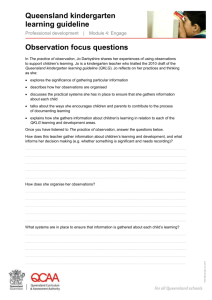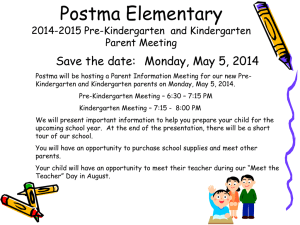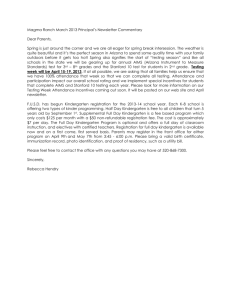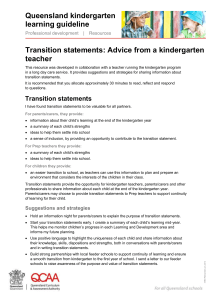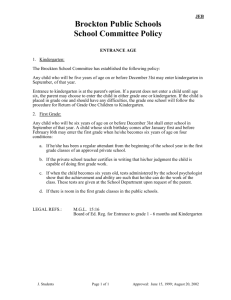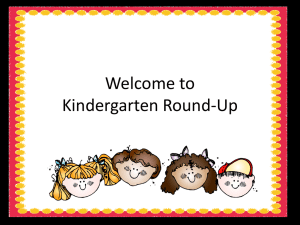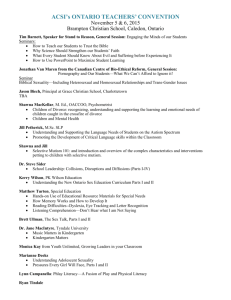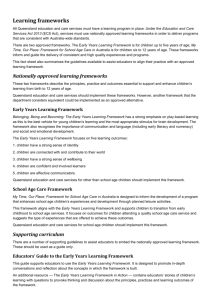Inclusion, A kindergarten teachers perspective
advertisement
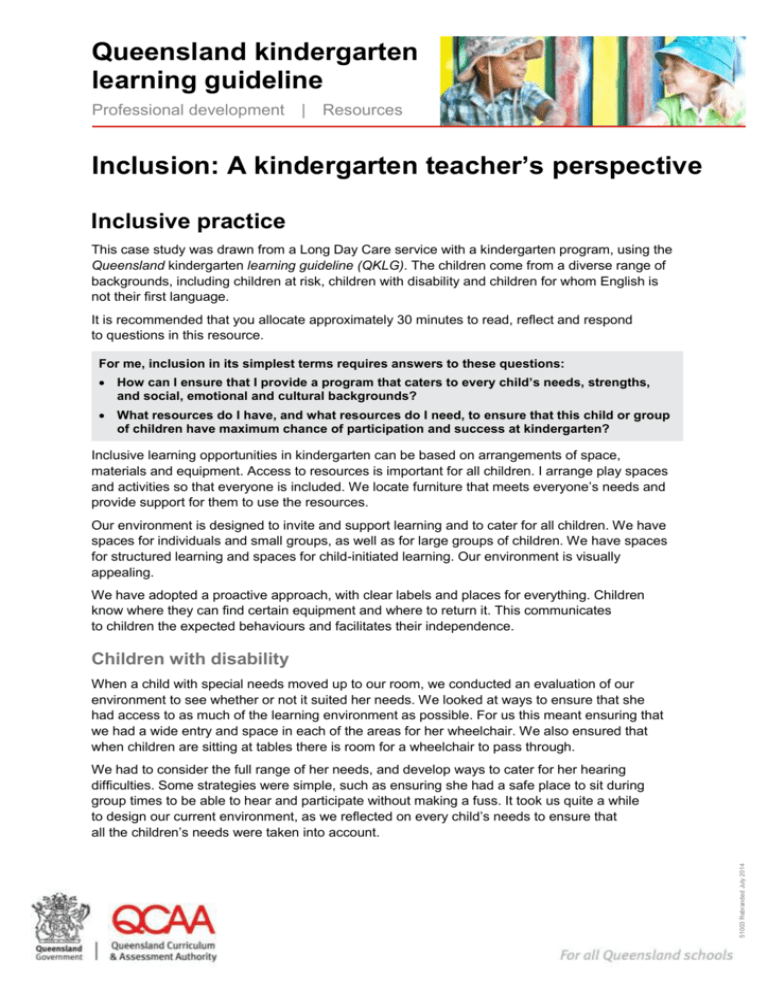
Queensland kindergarten learning guideline Professional development | Resources Inclusion: A kindergarten teacher’s perspective Inclusive practice This case study was drawn from a Long Day Care service with a kindergarten program, using the Queensland kindergarten learning guideline (QKLG). The children come from a diverse range of backgrounds, including children at risk, children with disability and children for whom English is not their first language. It is recommended that you allocate approximately 30 minutes to read, reflect and respond to questions in this resource. For me, inclusion in its simplest terms requires answers to these questions: How can I ensure that I provide a program that caters to every child’s needs, strengths, and social, emotional and cultural backgrounds? What resources do I have, and what resources do I need, to ensure that this child or group of children have maximum chance of participation and success at kindergarten? Inclusive learning opportunities in kindergarten can be based on arrangements of space, materials and equipment. Access to resources is important for all children. I arrange play spaces and activities so that everyone is included. We locate furniture that meets everyone’s needs and provide support for them to use the resources. Our environment is designed to invite and support learning and to cater for all children. We have spaces for individuals and small groups, as well as for large groups of children. We have spaces for structured learning and spaces for child-initiated learning. Our environment is visually appealing. We have adopted a proactive approach, with clear labels and places for everything. Children know where they can find certain equipment and where to return it. This communicates to children the expected behaviours and facilitates their independence. Children with disability When a child with special needs moved up to our room, we conducted an evaluation of our environment to see whether or not it suited her needs. We looked at ways to ensure that she had access to as much of the learning environment as possible. For us this meant ensuring that we had a wide entry and space in each of the areas for her wheelchair. We also ensured that when children are sitting at tables there is room for a wheelchair to pass through. 51003 Rebranded July 2014 We had to consider the full range of her needs, and develop ways to cater for her hearing difficulties. Some strategies were simple, such as ensuring she had a safe place to sit during group times to be able to hear and participate without making a fuss. It took us quite a while to design our current environment, as we reflected on every child’s needs to ensure that all the children’s needs were taken into account. Cultural and linguistic diversity For children who speak English as a second language, I provide access to a cultural support worker and source language kits to enhance communication with them. My service is located on a TAFE which provides Advanced English for Migrants Program (AEMP) courses. That means that we often have children come to us who have only been in the country a few days or weeks and speak little or no English. Some children in our care arrive from refugee camps. Children at risk When a child is identified as being at risk I feel it is important to: provide a safe environment develop safe, secure and trusting relationships communicate with carers, to develop an understanding of each child’s background work with parents/guardians/carers to support the child and ensure that they have access to the support and education they deserve provide reports to medical and legal teams where appropriate provide multiple copies of CDs with photos, graduation or other certificates, including transition statements, so that all adults who require it have access to information observe each child’s behaviour, identify areas for concern and follow up on these by reporting them to their parents/guardians/carers remain calm when the child discloses information that requires action allow children at risk to feel safe and secure by providing routines and specific teaching strategies know each child and their specific needs. Inclusive strategies I change teaching strategies daily as my group’s dynamics change. Knowing what works and what doesn’t for a certain group of children enables me to tailor my program. For example, I have multiple good morning/welcome songs. I know that some children require a short song whereas others enjoy movement. Teaching strategies are directed to individual children and to the group. I consider their age and ensure the strategy is developmentally appropriate. Behaviour strategies need to be trialled until there is a successful outcome. For a particular child at our kindergarten it was prompt cards. We took photographs of her doing the right thing, sitting on the mat, sitting at the table, lying on her bed, doing her puzzle. We developed boundaries for her by having visual cue cards with the correct behaviours. Assessment and planning are from a strengths-based perspective, to celebrate children’s achievements and work to improve areas that require further development. Routines and transitions Consideration of needs is important, and not only for children with special needs. We aim to reflect on every child’s needs and ensure that they are met in our environmental design as well as our teaching. QKLG Professional development Inclusion: A kindergarten teacher’s perspective Queensland Curriculum & Assessment Authority July 2014 Page 2 of 4 Organised schedule: Know your children and what works for them. Have an orderly and predictable routine and give notice of change. We do have a routine and much of it is flexible, however, there are segments of it that are predictable for children and they enjoy the predictability. Expectations are developed with the children, so that they understand and follow them. Questions for reflection Inclusive practice How can I ensure that I provide a program and resources to cater for every child’s needs, strengths, and social, emotional and cultural backgrounds? How can I make use of the indoor and outdoor environment to support all learners? How do I actively engage families to encourage them to share their joys and concerns for their child? QKLG Professional development Inclusion: A kindergarten teacher’s perspective Queensland Curriculum & Assessment Authority July 2014 Page 3 of 4 How can I actively build community partnerships? How do I value diversity? QKLG Professional development Inclusion: A kindergarten teacher’s perspective Queensland Curriculum & Assessment Authority July 2014 Page 4 of 4

